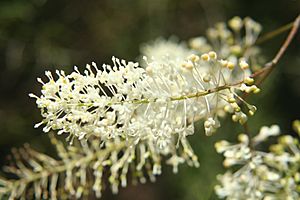Grevillea leptopoda facts for kids
Quick facts for kids Grevillea leptopoda |
|
|---|---|
 |
|
| Conservation status | |
| Scientific classification | |
| Genus: |
Grevillea
|
| Species: |
leptopoda
|
Grevillea leptopoda is a beautiful flowering plant that grows as a shrub. It is originally from Western Australia, especially near a town called Geraldton.
Contents
About Grevillea leptopoda
This plant is a type of shrub that can spread out or grow straight up. It usually reaches a height of about 1 to 1.5 meters (3 to 5 feet). Its branches are smooth, and its leaves are divided into many parts, measuring about 30 to 80 millimeters (1 to 3 inches) long.
What Does It Look Like?
Grevillea leptopoda blooms between August and November. Its flowers grow in clusters at the end of its branches. They can be white, pink, or cream-colored, with white styles (the part of the flower that receives pollen). After the flowers, it grows bumpy, oval-shaped fruits that are about 9 to 11 millimeters (0.35 to 0.43 inches) long. This plant only grows new plants from its seeds.
You might sometimes confuse Grevillea leptopoda with another plant called Grevillea teretifolia. That plant has a shorter flower stalk and longer pistils (another part of the flower).
Where Does It Grow?
Grevillea leptopoda is found in the Mid West and the Wheatbelt areas of Western Australia. You can find it from Kalbarri in the north down to Moora in the south. It likes to grow among medium to low trees in tall shrubland, mallee (a type of eucalyptus woodland), or heathland. It can grow in rocky, stony, or sandy soils that contain laterite (a type of red soil).
How Was It Discovered?
The plant was first officially described by a botanist named Donald McGillivray in 1986. He wrote about it in a journal called New Names Grevillea.
Grevillea leptopoda has a special conservation code in Western Australia called P3. This means it is "poorly known." It is not immediately threatened, but more research is needed to understand how many of these plants exist and where they grow.
Why Is It Special?
The flowers of Grevillea leptopoda have a strong, pleasant smell. Because of this, people sometimes plant it in their gardens, especially in warmer areas.
Images for kids
See also
 In Spanish: Grevillea leptopoda para niños
In Spanish: Grevillea leptopoda para niños



